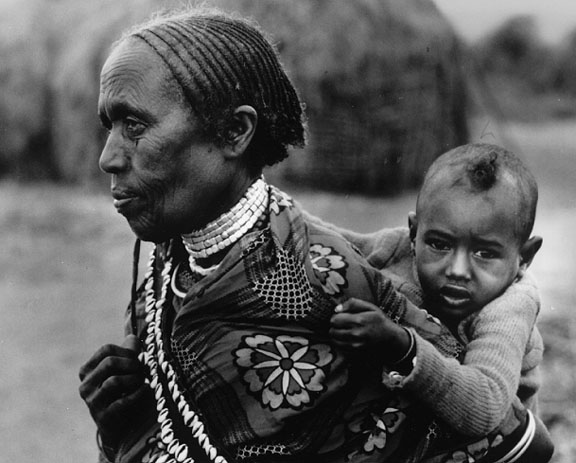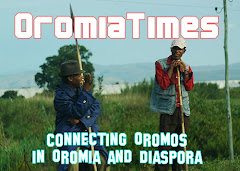Simon Roughneen 15 - 5 - 2006
The parched conditions in the Kenya-Somalia-Ethiopia borderlands are devastating the lives of Turkana and Oromo herders there, reports Simon Roughneen of the Irish development NGO Goal.
You would have to see it to believe it. Or rather, you would be forgiven for believing what you see, not knowing what truly lay on the horizon.
Driving through northern Kenya's drought-affected famine district as the midday sun lifts temperatures to over 40 degrees centigrade, pools of water shimmer in the distance, laying between dessicated trees and shrubs, with the mountains of Turkana peering through the haze.
But these aren't pools. There is no water here. By a cruel irony, this parched land taunts its thirsty and hungry people with distant images – mirages – of glistening oases in the distance. There hasn't been rainfall since 2004, according to Akwari Nubukwi, an elder in the village of Kanigipur in the southern Turkana district. "We use the water from the riverbed, where we dig to find it. But it is just a little water, and even the goats and dogs drink from it", he told me.
Simon Roughneen is working for the Dublin-based international humanitarian organisation Goal in northern Kenya and southern Ethiopia.
He has written a number of articles on the drought east Africa where Kenya, Ethiopia and Somalia meet
Goal has launched an Africa drought appeal and is working in northern Kenya and across Ethiopia to bring food and water to vulnerable people, and develop livelihood support programmes in advance of the next harvest season. Goal is also working against chronic food shortages and malnutrition in Malawi, Niger, Zimbabwe, in refugee and displaced-person camps in Sudan and Uganda. Click here for more information
The locals who are now suffering without water, whose animals – their main food and livelihood source – are dying, know better to be caught out by the illusion of water. Akwari adds: "Many animals have died. We haven't had rain for a year. People are losing their animals. We are hungry now."
But the downside of the much-needed rain can be seen elsewhere in northern Kenya. Move east towards Somalia, and flash-floods from the rains that have fallen there have displaced thousands, washed away roads, brought about water-borne diseases, and stalled aid efforts.
Despite knowing their environment well, people in the Turkana or Oromo regions of southern Ethiopia were unable either to predict or cope with the severity of the long drought. In Kenya, drought used to come every five years, and this region has always been food-insecure. Now drought seems endemic, and the local pastoralists' coping mechanisms are overwhelmed.
No time to lose
In Ethiopia, about 5 million people are in a chronic state of food dependence. Many parts of the country face a permanent emergency, which this latest drought has exacerbated. The humanitarian organisation Goal is coordinating a rapid-response programme, disbursing Usaid grants to other NGOs, as part of a push to track and react to drought and food crises.
The customary winter rains failed across northern Kenya and the Oromo and Somali regions of southern Ethiopia, leaving themselves and their animals without water. As the foliage died, the animals have been dying for want of food. And as animals die, the people here may not be too far behind.
No agriculture is possible in such a desolate place, and no jobs or alternative livelihoods are available in this remote, marginalised region.
400,000 metric tonnes of food aid for Kenya alone is needed, according to the World Food Programme (WFP). Turkana in northern Kenya is home to 600,000 people, out of an estimated 11 million people across eastern Africa that are affected by drought and food shortages. 3.5 million of those are in Kenya, east Africa's wealthiest country; 2.6 million Ethiopians and 1.7 million Somalis are also vulnerable.
The area where northeastern Kenya, southern Somalia, and Ethiopia share borders is especially badly affected. Lack of infrastructure, remoteness, marginalisation and insecurity both undermine local people's ability to deal with the harsh landscape and arid conditions, and hinder whatever aid effort can be mounted.
There have been rains – minimal, tantalising and indecisive. Father Bruno, an Italian missionary priest in the diocese of Lodwar, with which Goal is partnering to deliver food aid to the region, told me: "The rains are early. That makes me worried. For one thing, these rains will not cause any growth or improve the water issue for two months. And the early rains are not usual. They mean that something may happen to the rains later this year."
In southern Ethiopia, some rain has fallen as well. While welcome, it means that malaria and other diseases are likely to affect malnourished people whose resistance is lowered.
The United Nations has launched a $500 million appeal to meet food, water and livelihoods needs in the region. But unless the funding and resource shortfalls are addressed soon, people will start to die.
It is very simple. The people here need our help. If it doesn't come, promises of aid will be as the shimmering water in the distance to us: mirages. We have to act fast. Otherwise our promises will seem like mere sleight-of-hand, illusions placed in front of hungry and thirsty people.
Source: www.opendemocracy.net
Subscribe to:
Post Comments (Atom)

















No comments:
Post a Comment